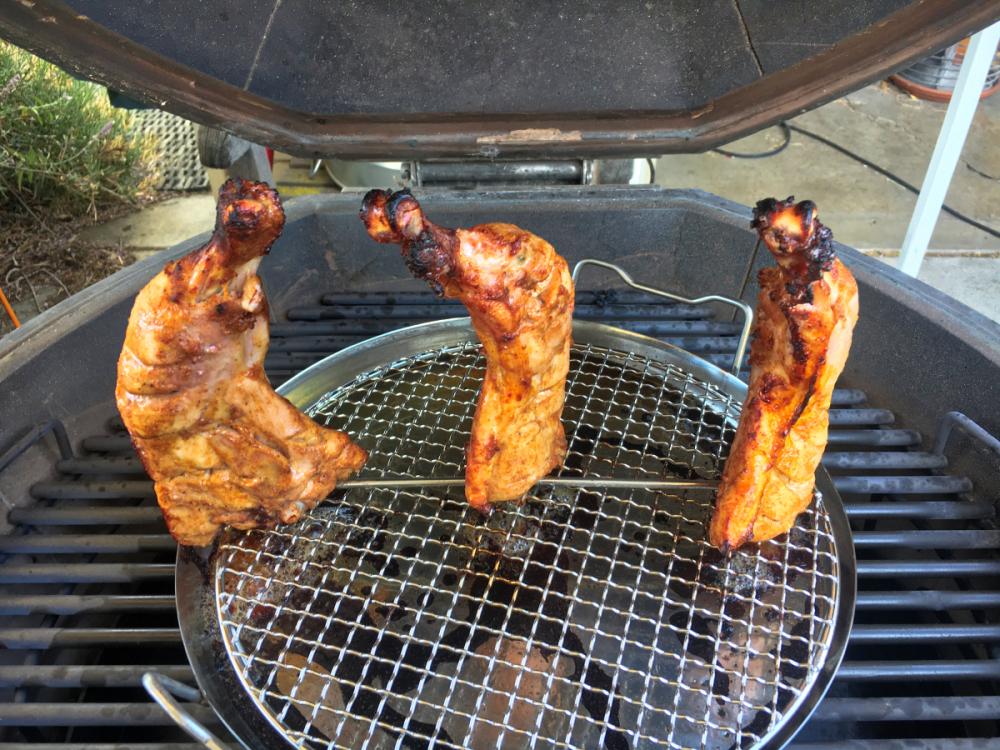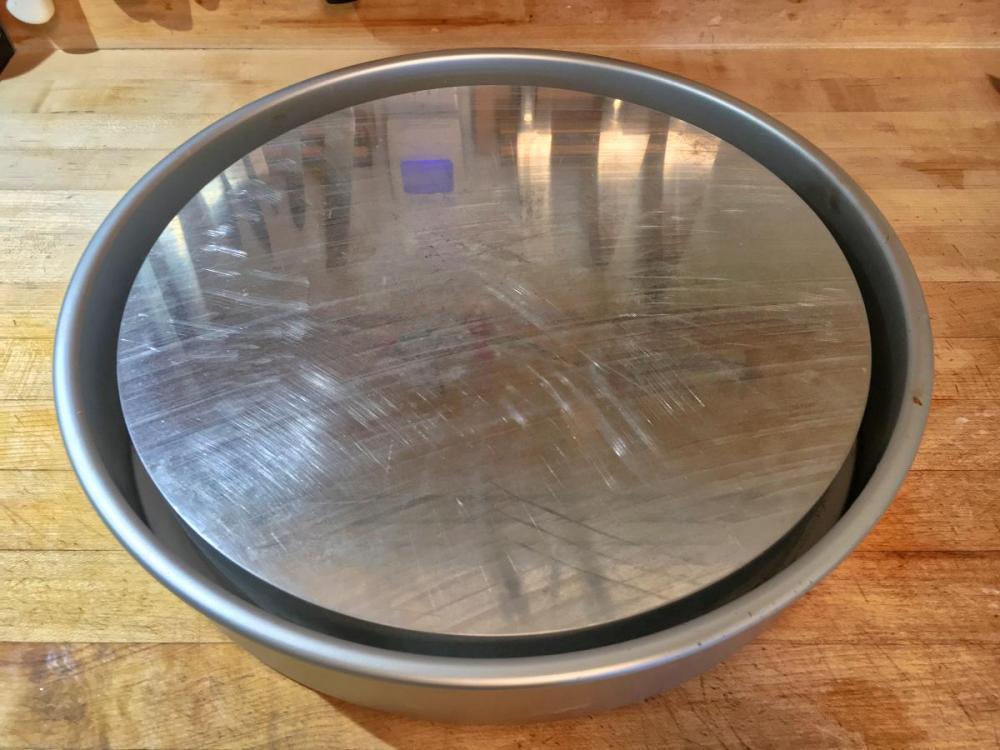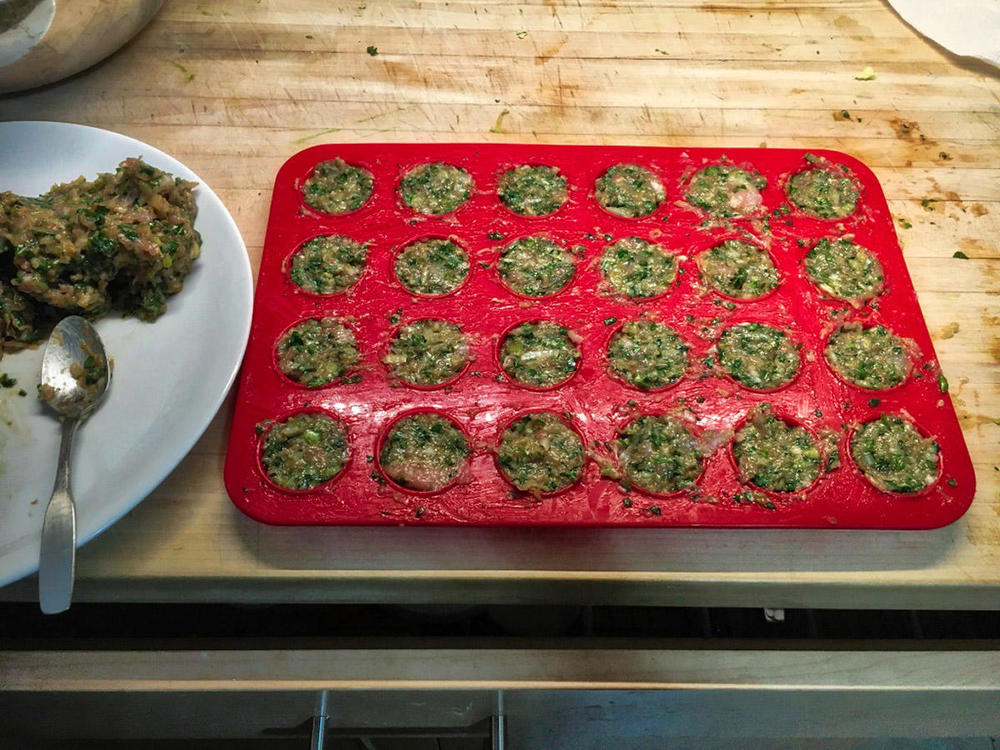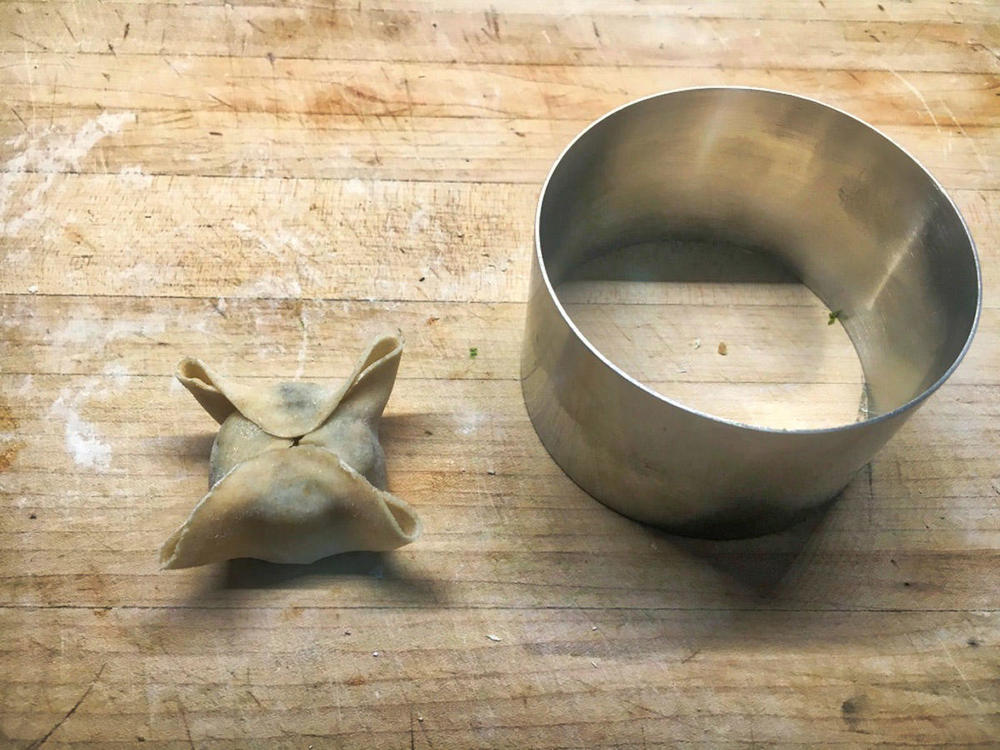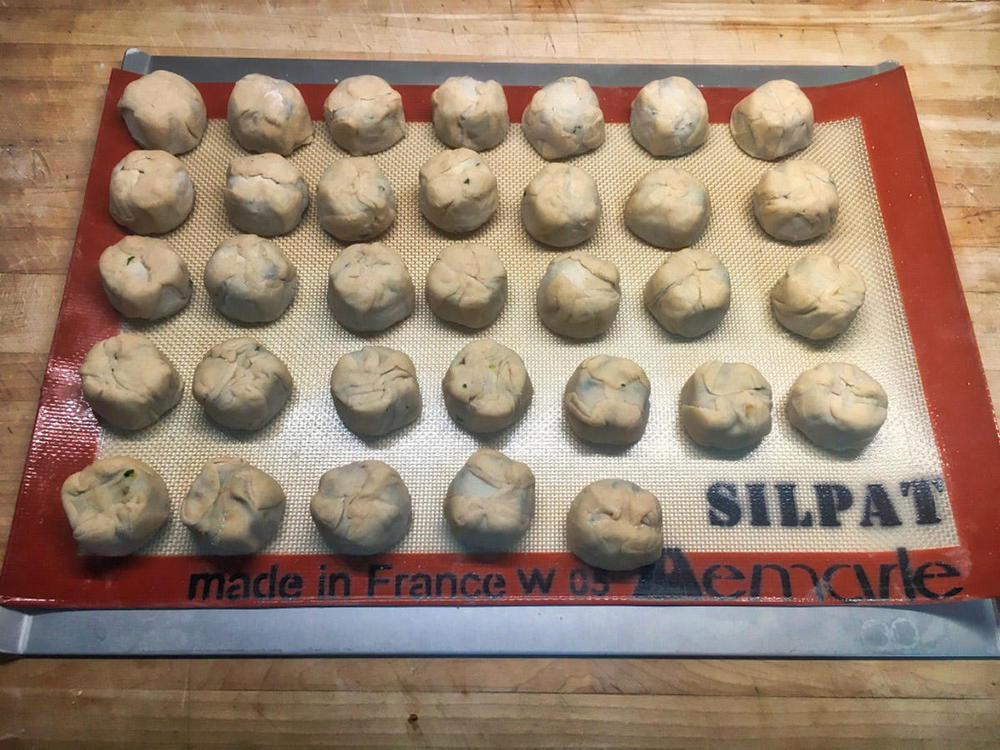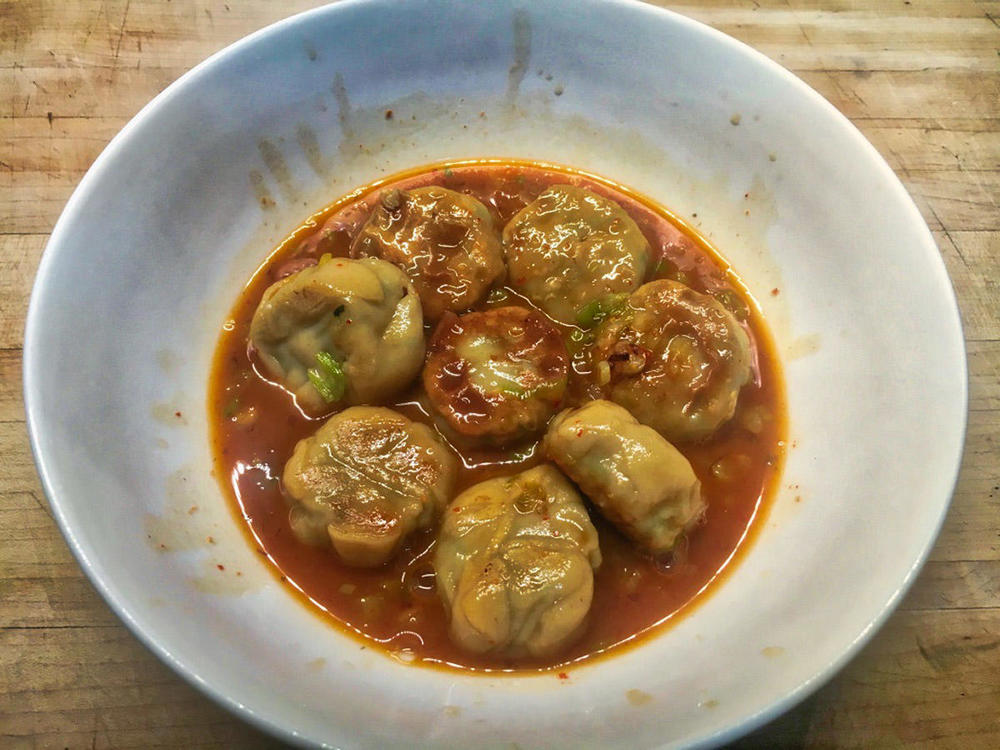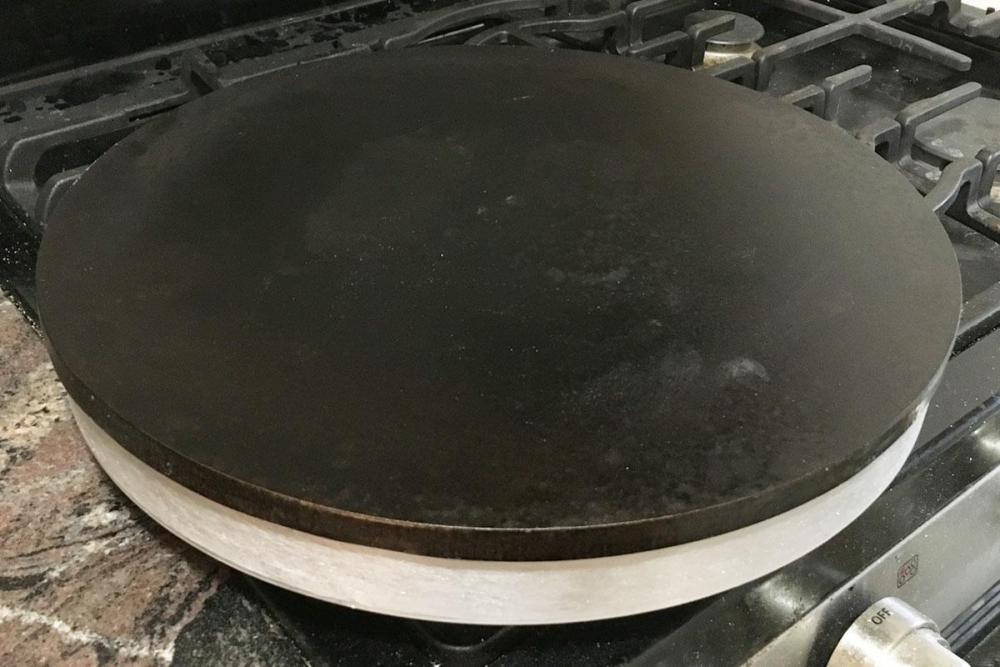-
Posts
303 -
Joined
-
Last visited
Recent Profile Visitors
2,933 profile views
-

Cooking time for whole chicken in tandoor oven
Syzygies replied to a topic in India: Cooking & Baking
The definitive English language Tandoor cookbook is Tandoor: The Great Indian Barbecue by Ranjit Rai, written for an Indian audience. Even if one is not using an actual tandoor, it is always better to translate once to one's equipment, than to translate twice via someone else's equipment. Ranjit Rai gives 250 Celsius as the traditional temperature for tandoori chicken in a tandoor, and 20 minutes as a cooking time. However, in any cooker based on fire, temperature is relative. How much convection? How much radiant heat? And chickens vary in size; my legs the other night needed half an hour. One can make decent tandoori in a ceramic cooker such as a Komodo Kamado. I recommend cooking indirect on vertical spikes such as the Trompo King Four Spike System. This comes apart into two pairs of spikes, and slides over any 1/4" vertical spike, that can be placed in any style of drip pan. One is not restricted to their system. -
I preheat my oven to 450 F for over an hour, with a baking stone on a rack, and this aluminum thermal mass on the floor. I have at the ready steam-proof mitts (silicone) and a container holding 350g to 400g of water. Just after putting in the dough, I put on the mitts and pour the water over the aluminum thermal mass, then quickly close the oven door. There is a serious risk of steam burns here. One won't get burned if one pours the water quickly from one side, wearing mitts, and closes the oven quickly. One will get burned if one forgets the mitts. The steam lasts a few minutes. For the Komodo Kamado, I use slabs of ice. It hardly matters; melting ice and bringing water to a boil take similar amounts of energy, dwarfed by the energy it takes to turn water into steam.
-
I use steam both in my indoor oven, and outdoors in a Komodo Kamado ceramic barbecue cooker. I got tired of cleaning yard schmutz out of my stainless steel chains, so I ordered a second aluminum disk off eBay. My steam generator now consists of one cake pan and two disks, all aluminum: Fat Daddio's PRD-163 Round Cake Pan, 16 x 3 Inch (Amazon) 1 Aluminum Disc, 1 1/4" thick x 14 3/4" dia., Mic-6 Cast Tooling Plate, Disk (eBay) To my surprise when I redid my calculations, aluminum has a significantly higher specific heat capacity than steel: Water, 4181. Aluminum, 897. Ratio: 21.5% Moreover, these disks are heavy. The cake pan and two disks combine to 44.9 pounds. So, in a ceramic cooker or oven heated to 450 F, this steam source can boil off 803 grams of ice, or 964 grams of warm (40 C) water. I rarely use more than half that, enough steam to replace the air in a KK or oven several times over. Perhaps I should have just tossed the steel chain, but now I have two aluminum disks. Nice. I posted this in a Komodo Kamado forum thread, where others have followed my lead, finding that one disk is plenty. (I'm best known there for devising a cast iron Dutch Oven "smoke pot" for a more subtle smoke flavor without the nasties. This got propagated to other BBQ sites.) KK as Steam Oven for Bread I was thrilled to get rid of the chains. They're messy and awkward.
-
As Rancho Gordo is to beans, Masienda is to corn: Masienda - masa supplies and ingredients Started in 2014, they sell 15 varieties of Mexican landrace corn for masa, along with supplies. As luck would have it, I recently gave away a never-used Indian wet grinder. I do have a commercial Vita-Prep blender, a Cuisinart food processor, and a Champion 2000 juice extractor with a nut butter mode. In another kitchen I have a long-discontinued Samap hand stone mill. I'm willing to buy either a metate and mano, or a Wonder Junior Deluxe+ Mill with masa auger (I distrust the less expensive equivalents). So I intend to figure something out, preferably stopping short of buying a Nixtamatic. This is a classis "perfect is the enemy of the good" situation. The goal is to make the best tortillas one can eat all the time, not a once-in-a-lifetime bucket list cook like making potato chips. I'm reminded of grinding and extracting my own coconut milk. One has to source the right frozen coconut meat: Our fresh coconuts have insufficient fat, and frozen brands vary; country of origin is a good clue. Then extraction still doubles the work in a meal. The best Thai chefs I know, who cook Thai all the time, can't give up years of their lives to this, so they have definite preferences on which brand of canned coconut milk to use. There's something artificial about cooking Thai outside Thailand in any case; in Thailand one would go to the market and buy coconut milk from one vendor, paste from another, ... Canned coconut milk is not the same, just as masa harina is not fresh masa. Nevertheless, these cooks get to eat Thai all the time. Prepping nixtamal is as easy as cooking beans from scratch. The crux move is grinding nixtamal into sufficiently fine masa. Here, I'm ready to place my bet that the winner is to grind wet in the Vita-Prep commercial blender, then thicken to the desired texture with masa harina, ideally something like Masienda sells. This is like cheating by adding white flour to whole wheat baked goods. Everyone does it. I'll report back, after I've compared every approach I can, using various Masienda corn varieties.
-
Yes. I also like how I can work with a wetter dough, and it sticks to the frozen filling as it starts to freeze, itself. I also like how I end up with no flaps. Flaps break off during freezer storage.
-
I cook frozen. For boiling, I like the Chinese "pour in cups of cold water several times" that replaces a need for a timer. A thermapen confirms that when they all float, they're done. For pan frying, "potsticker" approach as shown, cook as usual. A thermapen again confirms they're cooked through.
-
I've come up with a dumpling method I haven't seen anywhere, that's drop dead simple for cranking out many future meals: Freeze the filling in mini muffin trays, then press homemade wrappers around the filling as hard as you please. Ever since the Korean grocer H-Mart opened near Columbia, I've been living on their frozen dumpling section. Time to get back to making my own, better control of ingredients and meal balance. These mini muffin trays hold 20ml of filling each. A standard 3.5" circle cutter (mine is from Zabars) just reaches. Then smoosh the dough tight, and freeze. My dough is freshly ground hard red wheat, and boiling water. One could use any dough. Mrs. Anderson’s Baking 43631 24-Cup Mini Muffin Pan, Non-Stick European-Grade Silicone
-
22 pounds of aluminum stays at whatever temperature it's at. The box had been in trucks for days, and if my hands had been wet they would have frozen to the disk when I unpacked it. (Poor man's anti-griddle? Seriously.) It then took forever (well, an hour) for the above stack to reach griddle temperatures. Then I went off for office hours for several hours, and when I came back the aluminum was still too hot to touch. They make disks half this thickness, for $25. That may be a better bet, in which case what do you have to lose, trying experiments yourself? Not like investing in a Baking Steel.
-
eBay: 1 Aluminum Disc, 1 1/4" thick x 14 3/4" dia., Mic-6 Cast Tooling Plate, Disk (21.6 lbs, $54 USD) Some people prefer aluminum for pizza steels. One can find aluminum blanks on eBay, typically scrap from cutting holes in aluminum plates. I'm using an aluminum disk to help with even heat distribution for my custom 1/2" x 15" Baking Steel, which I use both stovetop and in the oven. It needed modest cleanup, to smooth edges and remove residues, easily accomplished with premium very fine sandpaper on a power sander, and then paper towels and rubbing alcohol.
-
Getting cooking advice from CI is like buying food at TJ's. One could do far worse. And those who do better don't need to read how on CI. Synthetic water stones are great, one doesn't need a natural stone that comes with its own island legend. But do get some sort of diamond stone for regularly flattening the water stones. Google "Atoma" for example. If we're going to suffer angst over other people's sharpening choices, feel bad for the people who have never reflattened their water stones. This isn't however the target audience of a CI article.
-
...which is an interesting way to win an argument, he suggests that those who don't understand are posers who ... uh ... don't understand. I have cellared wine for decades, and have various friends far further into this than I am. I have worked to acquire this taste. My cases of 1977 Giuseppe Quintarelli Amarone della Valpolicella were phenomenal after 20 years, though when I realized I could get $250 a bottle at auction, I stopped drinking them myself. Nevertheless, I'm calling the king has no clothes on. There's so much attitude and context that gets layered on older wines, covering the fact that most of them would have been better drunk a bit earlier. Better to err on the side of too young. (This was also my dating strategy until I married age-appropriate. There are arguments both ways there too, but the reality is age just means closer to death.)
-
You remind me of my take on cellaring wine. (I don't need a lecture on the theory: some wines are made to be aged, some cellars do a better job that others.) Drinking great wines both young and "properly aged", my take is that idolizing older wines is just old gheezers trying to put a positive spin on their own mortality. With few exceptions (Brunello comes to mind) I've always preferred the same bottle young.
-
We have two American Harvester round stacks, a total of 12 trays. The first design was moronic, placing the heater and fan at the bottom so juices would eventually destroy the unit. The new top-down design is fine. The total cost for two units and 12 trays is not far off from an Excalibur of similar capacity; one shouldn't decide on price. Cleaning twelve AH trays is a moderate nightmare; the ease of Excalibur cleanup could be the deciding factor here. We almost exclusively use these to process garden and farmers market tomatoes, for the year. We haven't opened a can of tomatoes in over a decade. A fair bit of work in season (like our agricultural past), and radicalizing; in even the fanciest restaurants, the taste of canned tomato becomes like the taste of a canned mushroom on a cheap slice of pizza. One doesn't want to be a snob, but one has a gag reaction, and regrets eating out. We use these packets for everything, but the signature use would be for a sauce with fresh pasta, from flour freshly ground in a Wolfgang Mock grain mill. The idea came from the "precious tomato" recipes of Colicchio, Keller and the like, which were too much work. We wash and scald 20 to 30 lbs of tomatoes, cool and skin, then slice and salt into the dehydrator. Reduce the weight by a factor of four over 8 to 12 hours (more wattage may not be better); this ratio depends on the tomato, as market tomatoes are often more watery. The result should be "gooshy", just wet enough to release enough juice to cover when pressed into a bowl overnight in the fridge (to equalize juices). Then partition into freezer packages, label and freeze till needed. The labels matter; farmers market tomatoes don't taste as good as garden tomatoes, late season are more acidic, and so forth, issues in selecting a packet for a particular application. Chamber vacuum bags work best, one can fiddle to get the air out, then seal them with a $30 impulse sealer, less work than a clamp or chamber machine, with an easier time dealing with the liquid. Zip lock bags work for a trial run but are far worse. The second staple that we're starting to depend on is Italian "strattu", a very concentrated tomato paste, air dried rather than simmered to death. Here, our preferred tomato is a Santa Cruz dry-farmed Early Girl, which a few farms bring to Bay Area farmers markets. Not the traditional choice, but the crown jewel of commercial tomatoes in California.The relatively pedestrian Early Girl is the strain uniquely best suited to that microclimate and technique. In Sicily, strattu would involve several days on special tables out in the searing sun. A dehydrator does a fine job. Strattu is however a relative space hog, and requires the lips on the fruit roll inserts for the American Harvester, so a half cup of liquid per tray doesn't run off before drying. Silpat liners would be great, but what does one do for a lip? I crave the 9 tray Excalibur for the extra capacity, but only if I can solve this problem. For comparison, an American Harvester tray is 11.5" in diameter with a 2" hole, so 12 trays (two units) is roughly 1200 square inches. A five tray Excalibur is a near match, and a nine tray Excalibur is over 2000 square inches. Preparing tomatoes to crowd the nine tray unit would be an operation that overwhelms most kitchens, but liberal spacing is always a good idea here. So what is the best way (think Silpat with a lip) to dry liquids (as for strattu) in the Excalibur? I'm tempted.
-
A circulator is a tool, nothing more, and one that we use all the time. One needs to unlearn the idea that sous vide is the centerpiece technique for fou fou skyscraper food at home. Remember the ancient idea that cookbooks were to help out for that rare "dinner party"? No such book gets opened, and no such device gets used. Identify technical flaws in conventional cooking, and swap in sous vide as a fix, but still remain in control of the outcome, actively intervening as one would in more familiar ground. These flaws are everywhere, not where one would expect from the prevailing association between sous vide and fancy food. A better association would be to see sous vide as originating as an unseen labor-saving device in restaurants, limiting the damage that less-skilled or less attentive cooks can do. Serious Eats tackled apple pie. All of the pitfalls of apple pie can be traced to the use of raw apples, and not everyone wants to saute the apples first as for galette. Sous vide is a great prep step here. By far, our most frequent use of sous vide is to prep vegetables, at 85 C or above for around an hour. Beet salad. Pan-fried potatoes is a great side. Better to get that twice-cooked thing going, like in french fries, but conventional approaches are unpredictable and often add water. Dice, sous vide, then chill the package (in an ice-water bath if you're rushed) as an ideal start. Set the circulator to 0 C to defrost freezer packages as fast as possible without cooking or entering the danger zone. (I wish that circulators had temperature alarms; one would be useful here.)
-
Controlled temperature and duration. Huh. Sounds like sous vide. I'm a big fan of general purpose tools such as my Anova One circulator ($200, -vs- $999 for the EZtemper). Or is there an undisclosed ultrasonic component in play here? If so, should we all be looking for other uses for an ultrasonic insert for our water baths? More quickly break down collagen in a long meat cook?



.thumb.jpg.1f815dea628f9536f43e2861f4a6f3cc.jpg)




